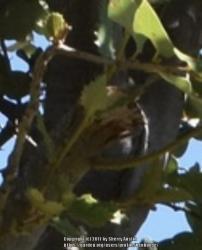I was looking at this little corner of the picture that showed serrated leaves. Most of my tan oaks are dead from Sudden Oak Death.. They were the first to go, so I don't have a lot to compare with anymore. I was thinking Canyon Oak (Q. chrysolepis) had spines on the edges, but looking online at pictures, the leaves can be either entire, or serrated.. So it could be that... Canyon Oaks and Interior Live Oaks (wislizenii) both grow in Southern California. I've got wislizenii all over my property, and I'm pretty sure it's not that..
I cut out the top left corner of one of the pictures where you can see serrated leaves if you enlarge..

